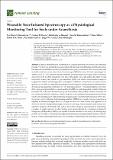Wearable near-infrared spectroscopy as a physiological monitoring tool for seals under anaesthesia
Abstract
Chemical immobilisation of pinnipeds is a routine procedure in research and veterinary practice. Yet, there are inevitable risks associated with chemical immobilisation, and the physiological response to anaesthetic agents in pinnipeds remains poorly understood. The current study used wearable continuous-wave near-infrared spectroscopy (NIRS) data from 10 trials of prolonged anaesthesia (0.5 to 1.4 h) induced through ketamine and midazolam in five grey seals (Halichoerus grypus) involved in other procedures. The aim of this study was to (1) analyse the effect of each compound on heart rate, arterial oxygen saturation (SpO2), and relative concentration changes in oxygenated [ΔO2Hb] and deoxygenated haemoglobin [ΔHHb] in cerebral tissue and (2) to investigate the use of NIRS as a real-time physiological monitoring tool during chemical immobilisation. Average group responses of ketamine (n = 27) and midazolam (n = 11) administrations were modelled using generalised additive mixed models (GAMM) for each dependent variable. Following ketamine and midazolam administration, [ΔHHb] increased and [ΔO2Hb] remained relatively stable, which was indicative of apnoea. Periods of apnoea were confirmed from respiratory band data, which were simultaneously collected during drugging trials. Given that SpO2 remained at 97% during apnoea, we hypothesized that increasing cerebral [ΔHHb] was a result of venous congestion as opposed to decreased oxygen delivery. Changes in heart rate were limited and appeared to be driven by the individual pharmacological actions of each drug. Future research could include simultaneous measures of metabolic rate, such as the relative change in concentration of cytochrome-c-oxidase, to guide operators in determining when apnoea should be considered prolonged if changes in [ΔHHb] and [ΔO2Hb] occur beyond the limits recorded in this study. Our findings support the use of NIRS as real-time physiological monitoring tool during pinniped chemical immobilisation, which could assist veterinarians and researchers in performing safe anaesthetic procedures.
Citation
Bønnelycke , E-M S , Hastie , G D , Bennett , K A A , Kainerstorfer , J M , Milne , R , Moss , S E W , Ruesch , A , Wu , J & McKnight , J C 2021 , ' Wearable near-infrared spectroscopy as a physiological monitoring tool for seals under anaesthesia ' , Remote Sensing , vol. 13 , no. 18 , 3553 . https://doi.org/10.3390/rs13183553
Publication
Remote Sensing
Status
Peer reviewed
ISSN
2072-4292Type
Journal article
Description
Funding: This research was funded as part of the Department for Business, Energy and Industrial Strategy Offshore Energy Strategic Environmental Assessment Programme. National Capability funding was provided by the Natural Environment Research Council to the Sea Mammal Research Unit grant number: NE/R015007/1. Supplementary funding supporting K.A.B. was provided by the Natural Environment Research Council grant numbers: NE/M013723/1 and NE/M01357X/1.Collections
Items in the St Andrews Research Repository are protected by copyright, with all rights reserved, unless otherwise indicated.

